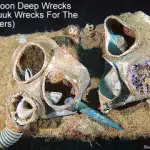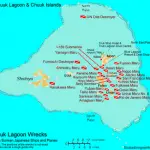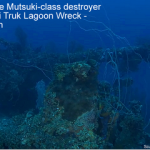
Truk Lagoon is possibly the best wreck diving location in the world, but how deep are the wrecks?
If you are planning a trip to Truk Lagoon in the near future, but need to know how deep are the wrecks in Truk Lagoon, this is a brief summary of the various depths.
The depth of the wrecks in Truk Lagoon are between 20-67 metres (66-220 feet). This means there are plenty of wrecks accessible to recreational divers in the 30-40 metre range (100-131 feet). The deeper wrecks over 40 metres (131 feet) are ideal for technical divers to explore on decompression stop dives.
There are some very deep dives, which are beyond the depths of a recreational diver certification (i.e. over 40 metres (131 feet)), but there are also wrecks that are shallow enough to enjoy as a recreational diver too.
The best way to dive Truk Lagoon is by a scuba diving liveaboard. You can check the latest and best deals on Truk Lagoon liveaboards using the following window:
I’m not sure if Truk Lagoon diving is suitable for beginner scuba divers though, as there are few dives to suit a beginner.
Truk Lagoon dive liveaboards table
This list of Truk Lagoon liveaboards is in descending customer rating order, followed by Scuba Diving Luxury Rating (SDE Lux Rating, see below), so the liveaboards with the highest customer rating and the best SDE lux rating will be at the top of the list. If you want to change the list order, use the “Sort by” dropdown below.
| Discover Liveaboard | Customer Rating | SDE Lux Rating % | Flexible Booking | Dive Courses | Dietary Requirements | Nitrox | Gear Rental | |
|---|---|---|---|---|---|---|---|---|
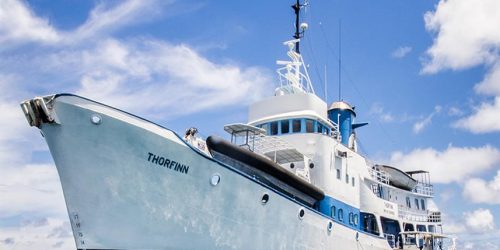 | Review: SS Thorfinn; Book: SS Thorfinn | 8.8 | 88% | YES | YES | YES | YES | YES |
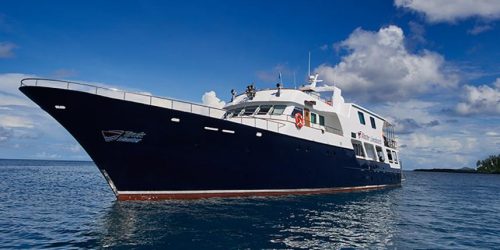 | Review: MV Truk Master; Book: MV Truk Master | 7.9 | 65% | YES | NO | YES | YES | YES |
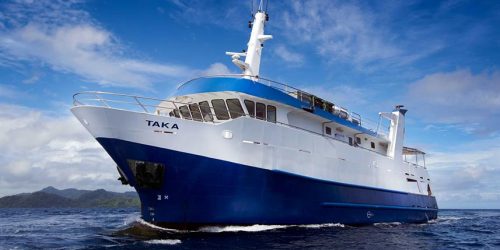 | Review: MV Pacific Master; Book: MV Pacific Master | 0 | 56% | YES | YES | YES | YES | YES |
The Scuba Diving Earth Luxury Rating (SDE Lux Rating) is explained on each liveaboard review when you click the “Discover Liveaboard” link, and is my own Liveaboard Luxury Rating I’ve assigned to all liveaboards. Choosing between liveaboards is helped by customer scores, and if you get stuck choosing between two or three liveaboards, where each one has a high customer score out of 10, you can use the SDE Luxury Rating to help narrow down your choice.
Think about it like using Booking.com when searching for the best hotel. Booking.com also use a customer score where each customer rates hotels out of 10. This is similar to the liveaboard customer rating, which is also rated out of 10. But let’s say you only like to stay in hotels rated 8 and above on Booking.com, but you also want the hotel to have WIFI or parking, or to have a swimming pool etc. The features each hotel has is usually secondary to the score out of 10.
How deep are the wrecks in Truk Lagoon – table of depths
The following table summarises the depths of the Truk Lagoon wrecks for ease of reference:
Truk Lagoon Wreck Depth Table
| Wreck | Depth Metres | Depth Feet | Profile |
|---|---|---|---|
| Aikoku Maru | 24-64 | 80-210 | 50M+ |
| Amigisan Maru | 34 | 110 | 30M |
| Fujikawa Maru | 15-37 | 50-120 | 35M |
| Fujisan Maru | 37-61 | 120-200 | 50M+ |
| Fumitzuki Destroyer | 30-40 | 100-130 | 40M |
| Futagami Tugboat | 15-28 | 50-92 | 30M |
| Gosei Maru | 3-37 | 10-120 | 35M |
| Heian Maru | 15-34 | 50-110 | 30M |
| Hino Maru No. 2 | 3-18 | 9-60 | 20M |
| Hoki Maru | 24-50 | 80-165 | 50M |
| Hokuyo Maru | 37-61 | 120-200 | 50M+ |
| Hoyo Maru | 3-30 | 9-100 | 30M |
| I-169 Submarine | 37-43 | 120-140 | 40M |
| Kansho Maru | 18-40 | 60-130 | 40M |
| Kikukawa Maru | 21-37 | 70-120 | 35M |
| Kiyozumi Maru | 12-37 | 40-120 | 35M |
| Matsutani Maru or Shotan Maru | 37-46 | 120-150 | 45M |
| Momokawa Maru | 37-43 | 120-140 | 40M |
| Nagano Maru | 43-64 | 140-210 | 50M+ |
| Nippo Maru | 37-47 | 120-155 | 45M |
| Oite Destroyer | 52-62 | 170-205 | 50M+ |
| Ojima - Tategami Class Salvage Tug | 46-50 | 150-164 | 50M |
| Reiyo Maru | 53-67 | 175-220 | 50M+ |
| Rio De Janeiro | 10-33 | 35-110 | 30M |
| San Francisco Maru | 42-64 | 140-210 | 50M+ |
| Sankisan Maru | 15-30 | 49-100 | 30M |
| Seiko Maru | 23-49 | 75-160 | 50M |
| Shinkoka Maru | 12-40 | 40-130 | 40M |
| Susuki Patrol Boat No. 34 | 3-15 | 10-50 | 20M |
| Taiho Maru | 27-44 | 90-145 | 40M |
| Unkai Maru No. 6 | 24-40 | 80-130 | 40M |
| Yamagiri Maru | 15-34 | 50-110 | 30M |
| Yubai Maru | 15-36 | 50-118 | 35M |
The above table is the depths of the wrecks in Truk Lagoon in both metres and feet. The max depth is roughly to the sea bed, so you may still be able to dive some of the wrecks on a shallower dive profile. This is so long as you limit your dive depth to your chosen planned dive profile depth.
Note: if you click on the column headings, the table will sort to this column.
Profile: This is a suggested dive profile depth (noting you may need to limit your planned depth to your chosen profile depth rather than the wreck's max depth noted in the above table of Truk Lagoon wrecks). Safety is should always be top priority and always remember: Plan your dive and dive the plan! Also, only ever dive to your certification level and level of diving experience.
To see the location of these wrecks on a map of Truk Lagoon, please follow this link to: Truk Lagoon wreck map.
How deep are the wrecks in Truk Lagoon in more detail
In this post ‘Truk Lagoon wrecks‘ I run through the various wrecks in Truk Lagoon. There’s also a table of each wreck you can dive giving brief details on each one.
Starting with the deepest wreck, which is the Reiyo Maru No. 6. This wreck at its shallowest point is in 53 metres (175 feet) of water. At its deepest point the Reiyo Maru No. 6 is 67 metres (220 feet) deep.
The word ‘Maru’ in Japanese ship naming protocol designates a merchant vessel.
These depths are clearly beyond the depths of a recreational scuba diver and into the realms of technical divers. At this depth you will need multiple tanks, mixed gasses or even better a rebreather.
You will be looking at spending plenty of time on decompression stops too.
That being said, there is great choice for most scuba divers at Truk Lagoon, it’s not just above technical diving. Let’s break this down into the depths of Truk Lagoon wrecks beginning with wrecks at 20 metres (66 feet).
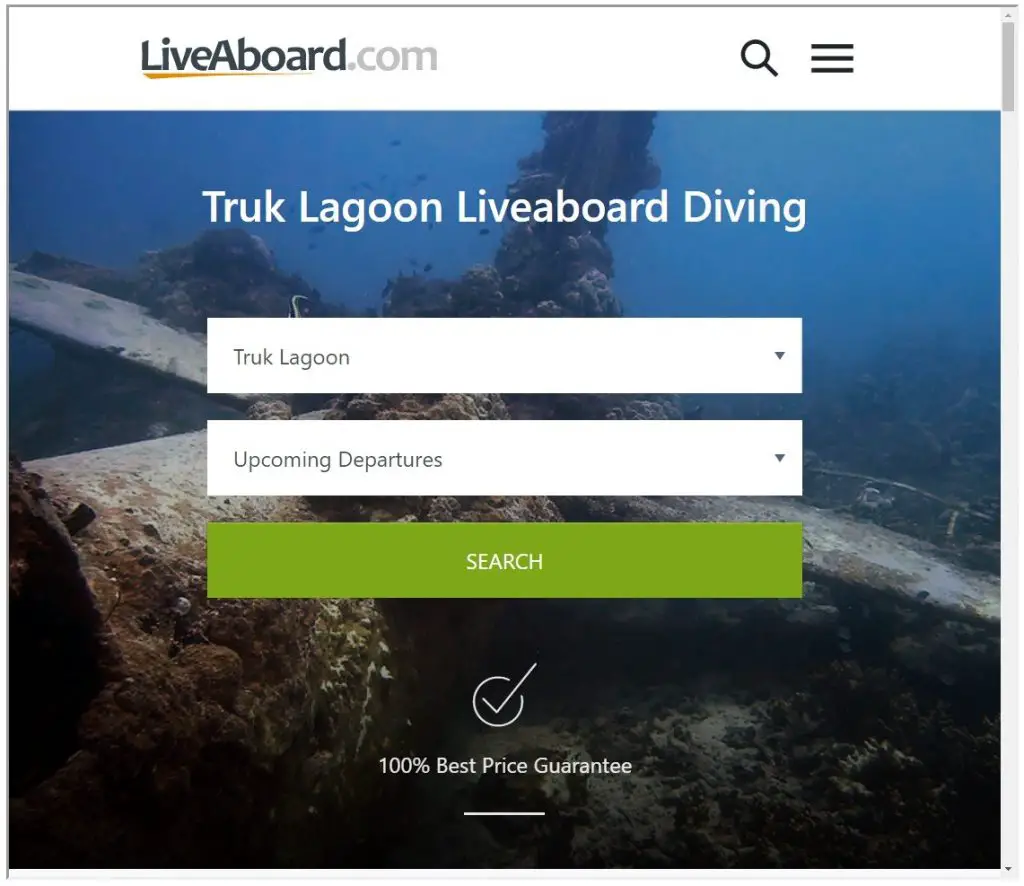
Wrecks in Truk Lagoon up to 20 metres (66 feet) deep
There are two wrecks that fall into this category first category. This is excluding the plane wrecks sitting in Truk Lagoon.
The two wrecks in Truk Lagoon in less than 20 metres (66 feet) of water are Susuki Patrol Boat No. 34 (15 metres or 50 feet) and Hino Maru No. 2 (18 metres or 60 feet).
Wrecks in Truk Lagoon up to 30 metres (100 feet) deep

There are a further three wrecks at 30 metres (100 feet) deep in Truk Lagoon. In addition to the above two wrecks in 20 metres (66 feet) of water, this makes a total of five wrecks at 30 metres deep.
The three additional wrecks include the Hoyo Maru, Futagami Tugboat and the Sankisan Maru.
Wrecks in Truk Lagoon just over 30 metres (100 feet)
Having added a further three wrecks to this range of dives, if you look at the table below, you’ll see a number of wrecks that are just over 30 metres (100 feet). These include wrecks sitting in 33-34 metres (110 feet) of water.
If you include these wrecks, there’s a further seven wrecks you can dive by limiting your depth to 30 metres (100 feet), which is a total of nine possible wrecks to dive in this depth ranger.
These wrecks could easily be dived as a 30 metres dive. This is so long as you keep to the 30 metre depth. Always remembering, the deeper you go the less time your air will last and the less time you can spend at that depth before going into decompression stop time.
Most detail about wrecks in the 30 metre (131 feet) depth range
The Sankisan Maru has several trucks lashed to the deck. There are many artifacts around her and most of her forward deck is covered in coral. Additionally, there’s an abundance of sea life and there’s excellent visibility on this wreck dive.
More Reading: Recovery of the Junkers Jumo 211 (recovery of underwater artifacts)
But the wreck which is featured in the above underwater photo is the
Hoyo Maru wreck.
The Hoyo Maru wreck was a tanker. At the time she was sunk, she was undergoing repairs due to being torpedoed in November 1943. She finally came to rest on the seabed on 17 February 1944.
As she sank, she capsized and now she lies upside down with a broken back. The engine room is damaged, but still accessible by scuba divers and the main hull is covered in hard corals.
The Hoyo Maru wreck is sitting at a depth of 3-30 metres (9-100 feet). She is 145 metres (475 feet) in length and weighed 8,691 tons.
She was built in 1936 originally as a commercial oiler, but was requisitioned by the Japanese Navy in 1941.
Truk Lagoon diving depths – up to 40 metres (131 feet)
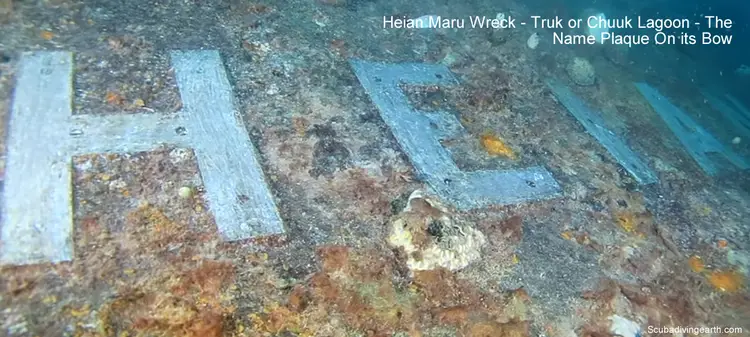
There are 19 wrecks which are sitting in a depth of 40 metres or less in Chuuk Lagoon (this total includes the five wrecks listed above in 30 metres of water).
That’s a lot of wrecks to dive on a scuba diving holiday. This means you don’t have to go extra deep to enjoy the Chuuk Lagoon wrecks.
However, 40 metres (131 feet) is still a deep dive and to make it worth your while, you will still need to do decompression stop diving. Otherwise your bottom time using PADI dive tables is just 10 minutes (BSAC is 12 minutes) at 40 metres (131 feet).
Even using Nitrox, which at 40 metres (131 feet) the maximum percentage of Nitrox is 28%, your dive time is still only 15 minutes without decompression stops. Not long to explore a large wreck!
In order to do decompression stop diving, you will need to get certified to do this type of diving. Additionally, you need to have significant experience and in my option 50+ scuba dives under your belt or better still 100+ dives completed.
Additional Truk Lagoon wrecks at 40 metres (131 feet)
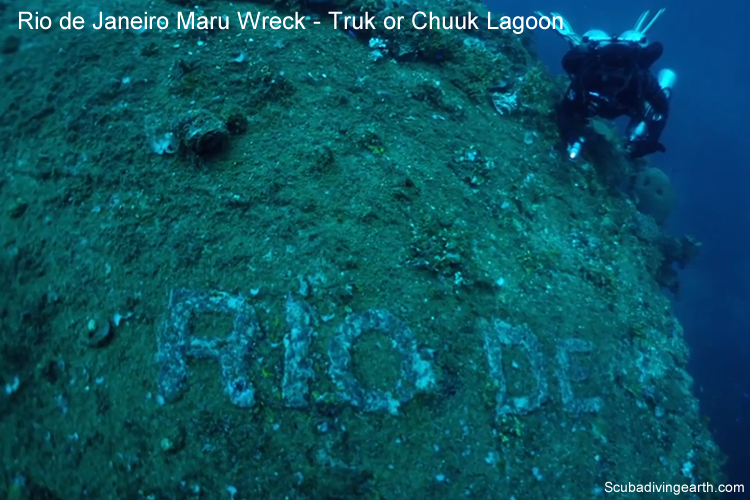
The wrecks which are in addition to the wrecks already listed in the 20 and 30 metre depth ranges above include Yamagiri Maru, Rio De Janeiro, Heian Maru, Amigisan Maru, Yubai Maru, Gosei Maru and Kiyozumi Maru.
The wreck Rio de Janeiro Maru, as featured in the above image, was a 140 metre (461 feet) long passenger liner. She was sunk on 17 February 1944 by US aircraft during Operation Hailstone.
Having said this, if you look at the table below, you could similarly include those wrecks that are just over the 40 metre (131 feet) mark. If you do this, but when you dive these wrecks limit your dive profile to 40 metres, there’s an additional 12 wrecks. These are the ones in the profile column note ’35M’ and ’40M’.
She is lying on her starboard side in 15-33 metres (50-110 feet) of water. There’s abundant see life and great visibility on this great diving wreck.
Points of interest for scuba divers include a huge stern gun, several large gun turrets and gun barrels in the holds. There are also many beer bottles and there’s good access to the wreck with an interesting engine room.
Truk lagoon diving depths – over 40 metres (131 feet) – The Truk Lagoon deep wrecks

The rest of the Truk Lagoon wrecks lie in waters in excess of 40 metres, starting with the I-169, as show in the above image. These are the Truk Lagoon deep wrecks. Subject to how you choose to categories the depths of the Chuuk Lagoon wrecks. The table below will help you with this task.
The I-169 Submarine along with the Momokawa Maru are only just over the recreational diver depth of 40 metres and sit in 43 metres (140 feet) of water.
In theory if you’re a recreational diver and you’d like to dive another two wrecks in Truk Lagoon, you probably can. Just so long as you stay off the bottom by the additional three metres (9 feet), you’ll be fine.
One other wreck you could include in your Truk Lagoon dive plan or itinerary, is the Taiho Maru, which sits in 44 metres of water. Again being careful with your maximum depth.
Truk Lagoon diving up to 50 metres (164 feet) deep
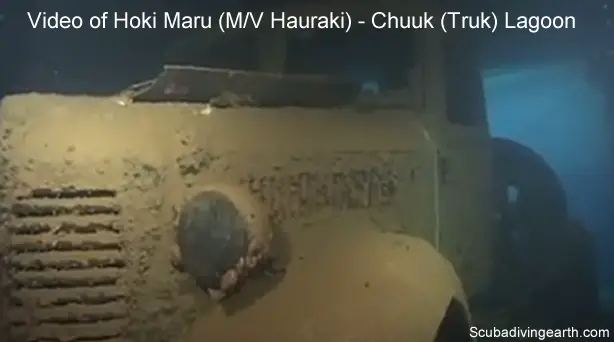
If you are a dive leader with BSAC, you are permitted to dive up to 50 metres (164 feet).
That means you are able to dive on a further eight wrecks in addition to the wrecks sitting in 40 metres of water. These include the ones discussed above sitting in 43-44 metres (140-145 feet) of water too.
The additional five wrecks include the Matsutani Maru or Shotan Maru, Nippo Maru, Seiko Maru, Ojima and the Hoki Maru wrecks. These are labelled ’45M’ and ’50M’ in the table below.
Truk Lagoon diving depths – over 60 metres (197 feet)
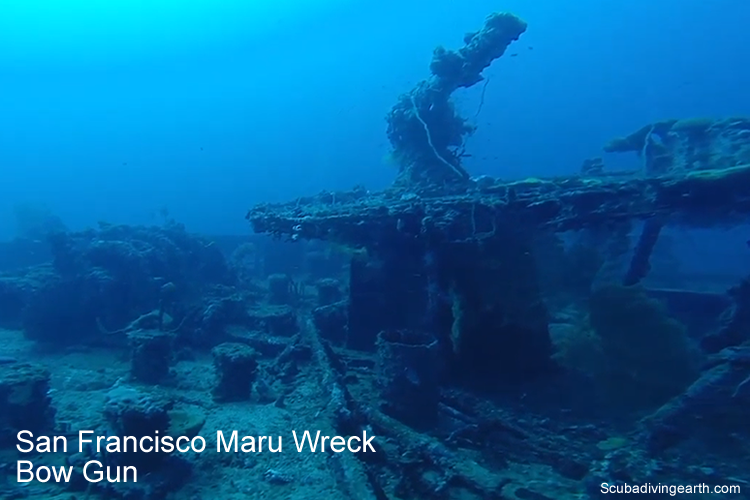
The rest of the wrecks in Chuuk Lagoon are in excess of 60 metres (197 feet) and will require advanced (even more than Advanced Open Water) and very deep diver experience and training. These are Truk Lagoon’s deepest wrecks.
For these depths of dive you will need to be introduced to mixed gas type diving and you may be better off using a rebreather. Although having said that, many technical divers still dive to these extreme depths using compress air tanks.
If you are a keen wreck diver and love to go deep, and you have the relevant certifications and experience, then you will probably want to dive on the San Francisco Maru and the Japanese Destroyer Oite.
The San Francisco Maru is considered to be one of the most exciting wrecks of Chuuk Lagoon. But even the deck is at 50 metres (165 feet), which makes it a wreck that can’t be dived as a recreational diver.
I hope you enjoyed this article about how deep are the wrecks in Truk Lagoon
I’d love to hear from you. Tell us about your adventures of diving and snorkeling, in the comments below. Please also share your photos. Either from your underwater cameras or videos from your waterproof Gopro’s!
If this article hasn’t answered all of your questions. If you have more questions either about snorkeling or scuba diving (or specifically about How deep are the wrecks in Truk Lagoon), please comment below with your questions.
There will also be many more articles about scuba diving (and snorkeling) for you to read and learn about these fabulous sports.
Have fun and be safe!

